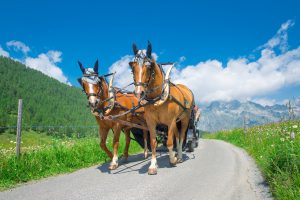When most people hear “horsepower,” they likely picture cars, engines, or even horses trotting around. But have you ever stopped to wonder what this term means? Horsepower is more than just a buzzword in the automotive world; it’s a measure of power that has evolved to become a standard in understanding engine performance and capability. The concept of horsepower has its roots in the 18th century when it was first introduced by James Watt to help market his steam engines.
But what does horsepower mean, and why is it so important? I believe understanding the origins and implications of horsepower can give us a deeper appreciation for this seemingly simple yet powerful performance measure. We’ve all heard of horsepower (hp) – an imperial unit of power commonly used to measure the power of car engines. Transporting us back to its origins, why was this unit of power called horsepower in the first place? This post will look at the origin of horsepower and how it’s used today.
A Background Study On The Origin of Horsepower
Horsepower, as a concept, originated in the 18th century with the Scottish engineer James Watt. While working to improve the efficiency of steam engines, Watt needed a way to quantify the power output of these engines in terms that the general public could understand. He coined the term “horsepower” to represent the amount of work a horse could do in a given time, making it easier for people to compare the capabilities of steam engines to the familiar strength of horses. Watt determined that one horsepower was equivalent to a horse lifting 550 pounds one foot in one second, or 33,000 foot-pounds of work per minute.
From a modern perspective, horsepower has evolved beyond its historical roots to become a critical factor in vehicle performance. While torque, another important measure of engine capability, relates to the rotational force produced by the engine, horsepower provides a comprehensive view of how quickly a vehicle can perform work over time. This is why we often hear car enthusiasts boast about the horsepower of their vehicles – it directly correlates to the speed and acceleration potential of the car.
If we look at the historical use of horses, we see that they have been primarily used as companions that transport goods, assist with heavy labor, and are modes of travel. These roles reflect horses’ natural strength, agility, and endurance abilities that far exceed other domesticated animals. Horses are now known as vessels of power, and they can work long hours, move heavy goods, and easily travel at high speeds.
Watt designed a machine (the original treadmill) that used a working draft horse that pulled a weighted mill wheel. Watt discovered that a horse could turn the mill wheel 144 times in one hour. The wheel was 12 ft. in radius, and the horse weighed around 180 pounds. Watt then used these calculations to compute the work rate at a specified time: horsepower.
Horses have greatly made life easier and inspired many daily inventions and technological developments. The first machines powered by horse innovation and the understanding of horsepower included grain grinders, feed cutters, corn shellers, threshing machines, silo blowers, pumps, and saws.

James Watt on his inspiration behind calculating horsepower:
“So that an engine which will raise as much water as two horses, working together at one time in such a work, can do, and for which there must be constantly kept ten or twelve horses for doing the same. Then I say, such an engine may be made large enough to do the work required in employing eight, ten, fifteen, or twenty horses to be constantly maintained and kept for doing such a work…”
Watt then used the foundation of horsepower to create one of the first modern steam engines. The International Unit of Measurement later accepted this unit of measurement for power as Watts (W). With further study, 1 HP was given an equivalent of 745.7 Watts.
Kinds Of Horse Powers And Conversions
There are now terminologies that are associated with measuring power or the rate of a machine’s productivity using horsepower:
• Mechanical horsepower
• Metric horsepower
• Electrical horsepower
• Boiler horsepower
• Hydraulic horsepower
• Air horsepower
These horsepower definitions use the unit of measurement, horsepower (HP), with equivalent values in Watts that differ. James Watt’s formula also allows for the conversion from Watts to Kilowatts.
Example if 1HP be converted to kw and 1 HP = 745.7 W then:-
745.7 w X 1 kw/1000 W = 1HP
1 HP = 745.7 kw/ 1000 1 kw
1 HP = 0.7457 kw
James Watt helped highlight how we can use the natural abilities of horses to influence modern technology. If you have any questions or fun facts about James Watt and the creation of horsepower, let us know!

The strength of horsepower lies in its ability to convey complex engineering principles in an accessible way. It bridges the gap between technical specifications and everyday understanding, allowing us to appreciate the power and potential of the vehicles we use. As we continue to push the boundaries of what’s possible in automotive technology, horsepower will undoubtedly remain a key indicator of progress and performance.





